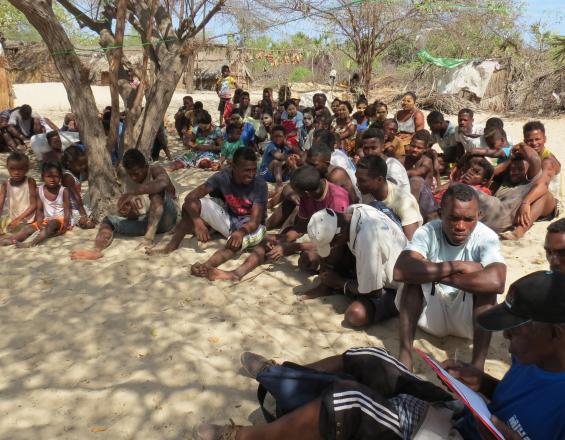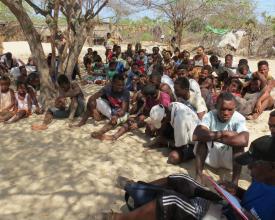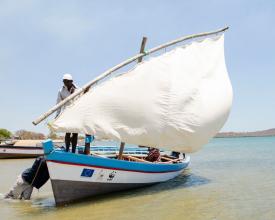
Pioneering climate change adapted MPA management in Madagascar
Full Solution

Community meeting in Nosy Hara
WWF
Threats posed by climate change on ecosystems and biodiversity in protected areas and human people are increasing. PAs can be also an effective tool to strengthen their resilience. This solution is therefore building resilient protected areas in Nosy Hara that can help to secure long-term use of ecosystem services by local communities in a changing climate, while improving protection of the area’s rich marine life by considering climate change into its management
Last update: 28 Mar 2019
8132 Views
Context
Challenges addressed
lack of knowledge of climate change and absence of long-term local climate data
Lack of climate change (CC) related knowledge among MPA managers; Lack of consideration of CC impacts in MPA management, potentially exposing highly resilient areas to harmful use due to limited protection, making ecosystems, species and local communities more vulnerable; Absence of long-term local climate data; Heavy reliance on small-scale fishery and traditional agriculture by local population
Location
Madagascar
East and South Africa
Process
Summary of the process
Capacity building gives clear orientation on the link between business as usual work and adaptation and how CC could exacerbate existing threats. Particularly, CC training allows understanding key concept of vulnerability assessment, basis of the revision of the management plan. Vulnerability assessment is mainly led by experts with MPA managers’ support. They could be able to bring valuable input on this process through knowledge they gained from the capacity building session. Quantitative analysis will be combined with traditional knowledge (gathered through the climate witness toolkit) in order to complete data gaps. VA outcomes will allow revising conservation status and level of threats as well as to identify highest resilient or vulnerable areas that need more attention. Adaptation option is defined upon the VA results. It will feed the management plan strategy which can address both climate and human induced impacts. A good understanding of CC key concepts will facilitate the identification of those adaptation options. Based on all the steps above, a climate-smart management plan is developed and will allow building a resilient MPA.
Building Blocks
Climate change capacity building for MPA managers
WWF has provided climate change related capacity building to Madagascar National Parks MPA managers, with the aim of updating their management tools by enhancing knowledge on climate change key concepts and potential impacts for coastal and marine areas. MPA managers were also trained to conduct reef resilience surveys to quantify basic resistance and resilience indicators for coral reef assessments. This particularly helps in monitoring the effects of sea temperature rise on coral reefs, incidences of coral bleaching and the effects of climate change on small-scale fishing.
Enabling factors
Useful training tools understandable by various targets including local communities. Practical examples that show the link between business as usual work and adaptation. Field exchange visit which helps MPA managers and local communities to learn from other adaptation experiences
Lesson learned
All initiatives on climate change adaptation (CCA) should start with capacity building to ensure a common understanding of climate change concepts by MPA managers, allowing them to apprehend its direct impacts to biodiversity and livelihoods and its interaction with existing threats. Capacity building allows putting in place appropriate management tools and strategy that helps to build a resilient MPA in a changing climate. Similar training tools should be developed for local communities as their involvement in the MPA management and monitoring is key.
Climate Witness Community Toolkit
The participatory Climate Witness Community Toolkit allows the documentation of local climate change impacts and devising appropriate adaptation measures for communities. It includes several participatory exercises, such as mapping, seasonal calendar or species inventory. The community is asked to identify changes that have occurred over the last years. The discussion will allow for identification of key problems with the main causes and adaptation options. The final outcome is a community action plan describing priority adaptation options.
Enabling factors
A mix of young and old people from each main villager category (fisherman, farmers, etc.) as well as non-active villagers - At least three days village meeting/workshop to discuss all the tools described in the toolkit. Discussion with a group of old people in the village who have good records of long-term past event and related impacts. Minimum level of climate change understanding of the surveyor (not necessarily for local communities)
Lesson learned
Relying on community knowledge helps to address the lack of long-term climate data and its impacts on livelihoods and natural resources, particularly in a country like Madagascar where this kind of data is missing at local level. It also serves as guidance to and complements further quantitative research, especially socio-economic vulnerability assessments. Results from using this tool will allow to adjust adaptation measures already implemented by local communities (which are sometimes a maladaptation) as well as to start implementing preliminary adaptation measures.
Vulnerability assessment to climate change
Vulnerability assessment was conducted to identify hotspots of climate change vulnerability and adaptation options that help to strengthen and/or maintain the site’s resilience, focusing on the MPA’s conservation targets. They allow an understanding of the status of bio-ecological and social targets with regards to climate change impacts and give guidance on how to increase their resilience. They were guided by multi-expert and multi-partners processes. Results will guide the revision of existing management plan.
Enabling factors
Multi-expert process considering linkages between MPA conservation and social targets but not a stand-alone analysis - Adapting renown methodology to local context and particularly to available data - Involvement of a GIS team in the VA process considering that the final outcome is a multi-target vulnerability map, one key decision tool for MPA managers to tackle future CC impacts - Use of standard and credible VA methodology that will allow to compare results from one site to another site.
Lesson learned
Linkages and synergies between each target vulnerability assessment should be established. A common scale is needed to produce an overall MPA vulnerability map and particularly to identify the most vulnerable area within the MPA that merits particular attention. Lack of data should not a barrier to start a VA, it can be complete by traditional knowledge. Simplify but credible VA methodology will help to move quickly to adaptation action in the ground instead of spending more than three years in this process.
Identification and implementation of adaptation options
Four criteria were used to prioritize the relevant adaptation option such as the range of benefits that the adaptation option provides, opportunities that enable its implementation, required costs for its implementation (capacity and resource needs, etc.) and risks at different level (social, ecological, economic, etc.). Identification and prioritization of adaptation options are a step by step process: - Step 1: For each VA target (ecological and social), experts in charge of vulnerability assessment have provided long list of possible adaptation options. - Step 2: this list were discussed with the MPA managers and stakeholders involved in coastal marine conservation and resource use, as well as other people working on PA issues (national and local authorities, NGOs, etc.) to prioritize those with highest potential to enhance resilience of MPA conservation targets and local people who depend on it. - Step 3: community consultations to check and validate if those prioritized adaptation options really address local needs, particularly those related to sustainable livelihoods.
Enabling factors
Build adaptation options on the vulnerability assessment outcomes. Assess the existing ground action to ensure complementarity between the activities (which lower the cost) and to avoid a long list of adaptation. Much focus should be given to adaptation option having multi-benefits - Conducting the prioritization process through a technical workshop and village meeting
Lesson learned
Participants should have at least a basic knowledge on climate change adaptation (CCA) to be able to better participate in the selection of right adaptation options. A sound understanding of the four criteria, their meaning, ranges and significance, by the participants before the prioritizing process is needed in order to avoid bias during the scoring exercise and to ensure they have the same level of understanding. Existing development and conservation initiatives in the area must be identified ahead to avoid redundancy of activities and to ensure complementarity with existing work that will lower the cost.
Review of management plan to integrate climate change issues
The MPA management plan should be revised in order to consider climate change issues. The purpose of this revision is to: update conservation targets status, identify new one should be added, review and revise threats, and adjust MPA strategy and monitoring protocols. Having this climate-smart management tools will ensure resilient MPA and long-term goods and services for local communities. It will guide MPA managers to anticipate future climate impacts.
Enabling factors
Training session on how to include CC into existing management plan Participatory process involving mainly MPA managers and expert on PA conservation and social targets Conducting vulnerability assessments (VA) is a pre-condition to including CC into an existing management plan. It provides substantial information on how CC affects the sensitivity and adaptation capacity of each conservation target, how existing threats are exacerbated and what strategy is appropriate. Gathering all information that is basis for the revision of the management plan
Lesson learned
In order to minimize current and future climate impacts, management plan can be revised using existing information (no need to wait for complete VA information) as it can be updated progressively. Link between CC and existing threats should be clearly defined to facilitate the level of CC impacts for each target.
Impacts
Improvement of MPA manager skills and understanding of climate change issues and their links with ‘business as usual’ work. Better knowledge of the status of conservation targets (species and ecosystems) and their level of vulnerability and resilience. Increased awareness of climate change and the relevance of marine protected areas in adaptation among practitioners and local communities; both in the project area and beyond, through the experiences and results of this initiative.
Beneficiaries
Nosy Hara MPA managers and local communities surrounding the MPA
Story
Contact solution provider for more information.



